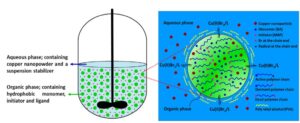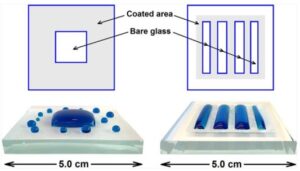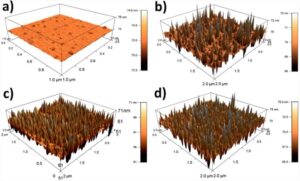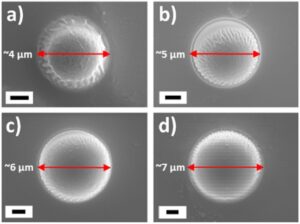
Surface Chemistry and Modification
- Post by: Leo
- June 11, 2021
- Comments off
Surface Modification: Self cleaning, anti corrosion, anti bacterial, impact resistance
Works have been accomplished…
-
Modify glass surface: Fabrication of novel hydrophobic, superhydrophobic, and oleophobic layers
-
No compromising on glass transparency
-
Facile coating methods: One-pot “grafting to” methodology using “thio-bromo click” chemistry
-
Controlled polymerization of hydrophobic monomers in water

Schematic representation of Cu(0)-mediated RDRP in suspension

Water containing 200 ppm methylene blue dye on the surface of glass coated in the specified regions with NSPHFIPA.

AFM topographic images of (a) a blank glass slide, and slides coated with (b) NS-PBA, (c) NS-PTFEM, and (d) NSPHFIPA via one-pot “grafting to” methodology

SEM photographs of the individual particles from the reaction mixture of Cu(0)-mediated RDRP of BA in water containing a) 10.0 wt% PVA (∼4 μm); b) 5 wt% PVA (∼5 μm); c) 2.5 wt% PVA (∼6 μm), and d) 1.0 wt% PVA (∼7 μm) (scale bar=1 μm).

(a) Chemical route and (b) schematic representation of the one-pot “grafting to” approach for the attachment of Nspolymer-Br onto the glass surface.
Peer-reviewed Publications
-
Cu (0)-mediated reversible-deactivation radical polymerization of n-butyl acrylate in suspension (https://doi.org/10.1016/j.polymer.2018.08.044)
-
Facile preparation of superhydrophobic and oleophobic surfaces via the combination of Cu (0)‐mediated reversible‐deactivation radical polymerization and click chemistry (https://doi.org/10.1002/pola.29049)
-
Glass surface modification via Cu (0)-mediated living radical polymerization of fluorinated and non-fluorinated acrylates (10.1039/C7PY01530E)
Categories: